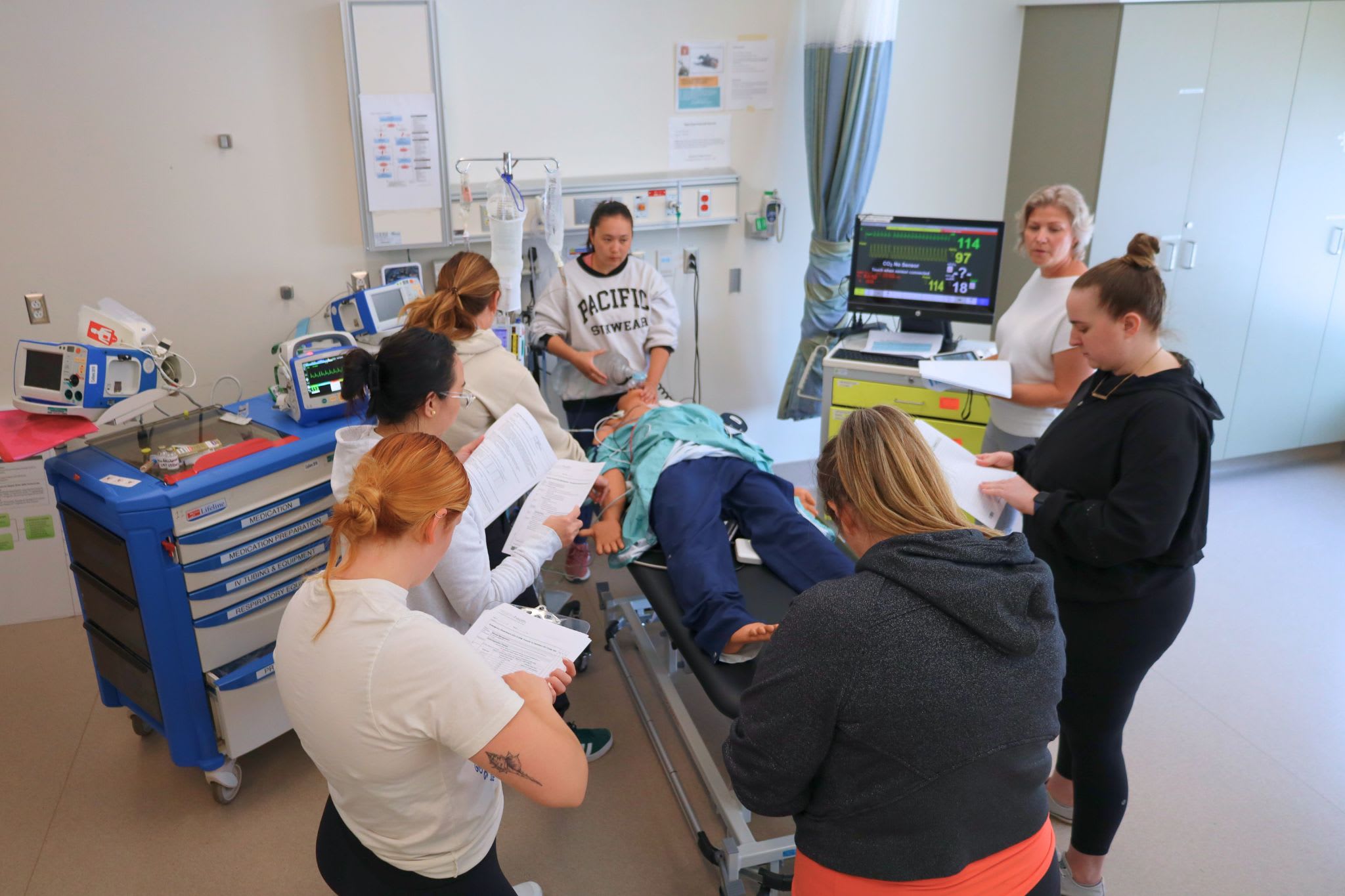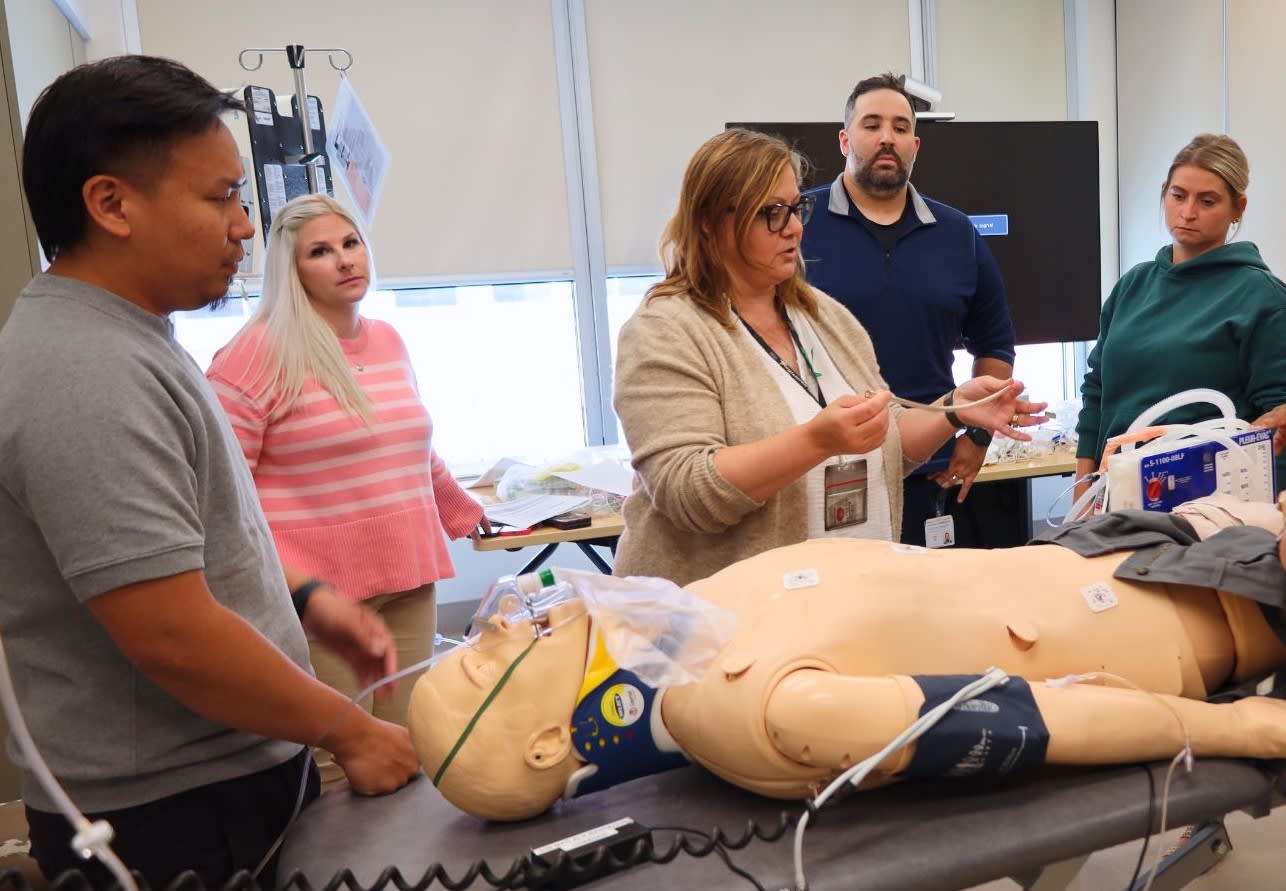
Healthcare professionals collaborate in a SIM education session, practicing real-world scenarios to improve patient outcomes and build confidence in high-pressure situations.
In one room, a patient is experiencing cardiac arrest. In the next, a trauma patient awaits care for severe injuries. Nurses work together, applying their skills and knowledge to stabilize their patients, their every move critical to saving lives.
But here’s the twist: these patients aren’t real. They’re advanced simulation (SIM) mannequins, and the high-stakes medical emergencies are carefully crafted simulation exercises developed and executed by the Professional Practice team at Niagara Health.
Using advanced technology and realistic scenarios, SIM education transforms clinical learning by replicating real-life medical emergencies in a risk-free environment. For nurses, physicians and other health professionals, these sessions are an opportunity to refine their skills, strengthen teamwork and build confidence – all while ensuring the best outcomes for real patients when it matters most.
“Nurses working in the Emergency Department face incredibly high-pressure situations every day,” says Ashley McLean-Duncan, a Nurse Educator at Niagara Health. “Simulation training allows them to rehearse those scenarios, think through the steps they need to take and learn from opportunities for growth and skill building in a safe, supportive setting.”
A safe space to learn
At the heart of SIM education training is Clair, a medium-fidelity simulation mannequin with realistic features. Clair can breathe, speak and even mimic physiological responses like a racing heartbeat or blocked airway.
“Clair’s capabilities make her an invaluable tool,” says Natalie Ferraro, Director, Professional Practice and Education. “Staff can practice everything from CPR to administering medications, all while navigating realistic, high-pressure situations.”
Each SIM session begins with a briefing, where participants are introduced to the medical scenarios they’ll be tackling. From there, they step into action. In the cardiac arrest station, nurses perform chest compressions, intubate the patient and deliver life-saving medications. At the trauma station, they assess injuries, stabilize fractures and manage severe bleeding.
“Nurses need to be prepared for anything and the simulation helps them to think on their feet,” says McLean-Duncan. “It’s not just about clinical skills, it’s about communication and teamwork. Those are the keys to success in any emergency.”
SIM training and learning scenarios are designed to identify opportunities for further development and skill building, ensuring participants have the knowledge, skills and confidence to respond effectivity. Challenges and areas for improvement are not only expected but welcomed as opportunities for growth. After each session, participants gather for a debriefing to reflect on successes and explore ways to enhance performance.
“This is where the real learning happens,” says McLean-Duncan. “Staff can see how their actions impact the scenario and hear feedback from their peers and instructors. It’s a chance to refine their approach and build their confidence.”
The response from participants has been overwhelmingly positive. Nurses report feeling better prepared to handle real-life emergencies and appreciate the chance to practice in a no-risk environment.

Team members work together during an education session, honing their teamwork and critical care skills using SIM technology.
Preparing for the unexpected
For Niagara Health, SIM education isn’t limited to emergency nursing. It’s an interdisciplinary effort involving doctors, respiratory therapists and other healthcare professionals. These sessions reflect the collaborative nature of hospital work and ensure that every team member is equipped to handle high-stakes situations.
“Simulation training sharpens critical thinking and enhances communication,” says Ferraro. “That translates to better patient care and improved outcomes.”
The program is also expanding. In additional to using medium-fidelity mannequins like Clair, Niagara Health plans to incorporate high-fidelity simulations and scenario-based training for specific clinical challenges.
While the mannequins may not be alive, the lessons they provide are life-saving. Participants leave the training room with more than just technical skills – they gain confidence, clarity and the ability to work seamlessly as part of a team.
“As healthcare evolves, so do the challenges our staff face,” says Ferraro. “Simulation training ensures that our teams are ready for anything. By preparing our teams for real-world challenges in a safe, innovative environment, we ensure better outcomes for both patients and the professionals who serve them.”

